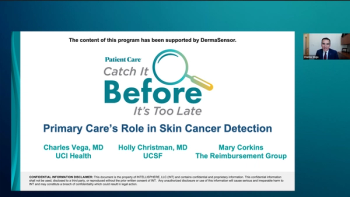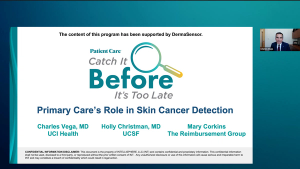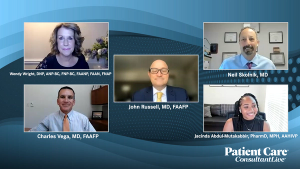
FMX 2025 highlights for primary care include expert insights on vaccine confidence, chronic cough management, and vascular disease prevention.

FMX 2025 highlights for primary care include expert insights on vaccine confidence, chronic cough management, and vascular disease prevention.

Panelists discuss billing and coding procedures for skin scanning devices, focusing on the use of unlisted Current Procedural Terminology (CPT) 99 codes with proper documentation and modifiers, the importance of clear communication with billing teams, available educational resources to aid primary care settings, and operational considerations including scope-of-practice variations for device use among clinical staff.

Panelists discuss an interactive case session emphasizing the nuanced evaluation of suspicious skin lesions, highlighting tools such as the DermaSensor for risk scoring, the ugly duckling concept, and the importance of combining clinical judgment with technology to guide biopsy decisions and patient follow-up across diverse skin types.

Panelists discuss that decisions to forgo biopsy often weigh patient risk and lesion characteristics with noninvasive tools offering valuable reassurance; while familiarity with artificial intelligence (AI) aids varies, these technologies—used judiciously and alongside clinical expertise—can boost diagnostic confidence, though limitations and integration challenges remain.

Panelists discuss that successful adoption of artificial intelligence (AI) skin cancer detection tools requires proven effectiveness, easy integration into clinical workflows, appropriate reimbursement, and use as supportive aids that complement—not replace—clinical judgment.

Panelists discuss how visual examination remains the primary method for evaluating suspicious skin lesions in everyday practice, emphasizing clinical judgment, patient-reported changes, and the growing—but still limited—role of artificial intelligence (AI) tools, while underscoring the importance of vigilance, especially in high-risk and underserved populations with limited access to dermatology.

Panelists discuss the challenges of skin cancer evaluations, highlighting patient fears, systemic access barriers, and provider concerns about overreferral, while emphasizing the importance of clear communication, responsible resource use, and cautious adoption of emerging tools such as artificial intelligence (AI), with clinical judgment and trusted educational resources remaining central to care.

Panelists discuss the anxieties primary care providers face in skin cancer evaluation—particularly the fear of missing a malignancy—while highlighting challenges such as limited diagnostic confidence, delayed dermatology access, and disparities in underserved areas, emphasizing the need for better tools and support to empower frontline clinicians and improve early detection.

Panelists discuss the vital role of primary care providers in early skin cancer detection, highlighting the need for improved diagnostic confidence, integration of artificial intelligence (AI) tools, and efficient workflows to overcome time and resource constraints, ultimately aiming to reduce delays and improve patient outcomes.

Drs John Russell, Jacinda Abdul-Mutakabbir, Charles Vega, Wendy Wright, And Neil Skolnik provide their practice pearls and key thoughts on how to vaccinate their patient populations in the upcoming influenza season.

Drs Jacinda Abdul-Mutakabbir and Charles Vega share their expertise on how to vaccinate a 65-year-old male patient with an egg allergy.

A panel of experts in vaccination efforts discuss the available influenza vaccines for a 50-year-old male patient with a heart disease.

John Russell, MD, FAAFP, presents the case of a 30-year-old pregnant woman in her 2nd trimester and reviews the appropriate vaccination strategies for this patient.

Dr John Russell and Neil Skolnik comment on how to translate the advisory committee on immunization practices influenza vaccination recommendations to patients.

Dr Neil Skolnik reviews the role of real-world data to examine the efficacy of influenza vaccines and their impact on influenza related complications.

A panel of experts in vaccination share their thoughts on the optimal timing and administration of an influenza vaccine for the general public.

Dr Wendy Wright reviews the differences between influenza strains and the rationale for the inclusion of multiple viral strains within flu vaccines.

Neil Skolnik, MD, reviews the currently available vaccine technologies, highlighting their mechanisms of action and individual delivery methods.

A panel of experts in vaccination uptake strategies discuss their best practices for empowering their patients to obtain flu vaccines and discuss how to personalize these conversations.

Jacinda Abdul-Mutakabbir, PHARMD, MPH, AAHIVP, leads a conversation on the importance of vaccination in the defense and protection against viral infections, such as the flu.

Wendy Wright, DNP, ANP-BC, FNP-BC, FAANP, FAAN, FNAP, shares her thoughts on the changing perception of influenza and influenza vaccination post the COVID-19 pandemic.

Well-known ID specialist Bill Schaffner, MD, and active primary care educator Chuck Vega, MD, offer thoughts on how to get shots into arms in the 2023-2024 respiratory virus season.

Respiratory virus season 2023-2024 will likely be a "transition year," according to family physician Chuck Vega, MD and ID specialist Bill Schaffner, MD. Here's why.

Published: June 26th 2025 | Updated:

Published: October 15th 2025 | Updated:

Published: August 22nd 2023 | Updated:

Published: October 17th 2023 | Updated:

Published: August 21st 2023 | Updated:

Published: September 26th 2023 | Updated: